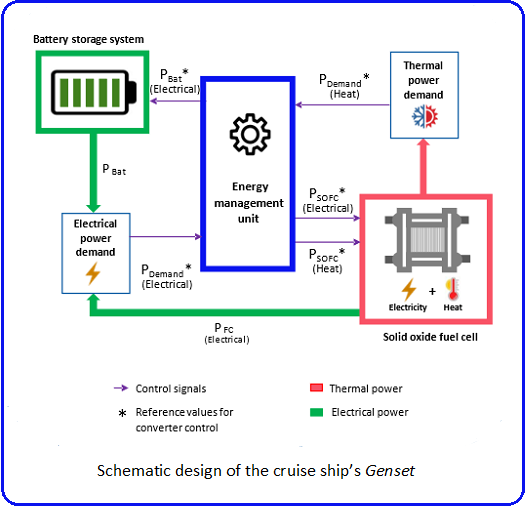Stricter emissions targets, especially on CO2 posed by international organisations are encouraging ship owners and ship constructors to innovate. Indeed, such innovation can be done by utilizing other fuels than heavy fuel oil (HFO).
There is a variety of options to choose including the usage of low-sulphur fuels or liquefied natural gas (LNG) as a source of energy. Other alternatives are exhaust-cleaning devices such as scrubbers. However, as neither of these solutions can be solely utilized in the long run, a hybrid propulsion system, which can be installed on both existing and new vessels, will be developed within the NAUTILUS project.
The technology solution which is proposed and is currently under development is a hybrid propulsion system of a cruise ship called Genset that consists of a solid oxide fuel cell (SOFC) system and a battery storage system as shown in the above schematic design of the Genset of the cruise ship. The battery storage system of the NAUTILUS propulsion system is a lithium-ion battery pack.
Such a hybrid propulsion system shall fulfil the total power demand (electrical as well as thermal) at every operational instance to guarantee a reliable and uninterrupted operation of the passenger ship. Neither the SOFC nor the battery storage system can solely fulfil the total power demand. This is due to the fact, that the SOFC system is limited by output power dynamics due to various electrochemical and mechanical processes involved. Furthermore, the battery storage system is limited by its energy density and storage capacity. To address this issue, both propulsion components are coupled, and the total power demand of a cruise ship will be split between the available power sources. The power-split will be developed to guarantee a continuous system operation and ideally lead to near-optimal fuel consumption and reduce the degradation of the power sources. These objectives are defined as parts of this work package within the NAUTILUS project.
The distribution of electrical power to the propulsion components of the Genset requires intelligent control and management. The project partners within the NAUTILUS projects are therefore developing a control unit that meets all the above requirements and can ultimately be embedded into the ship's grid. This Energy Management Unit (shown in the schematic design above) is dedicated to the power management and control of the Genset. The Energy Management Unit will ensure that the total electrical power demand will be delivered by the Genset, consisting of the SOFC and the battery storage system. Furthermore, this Energy Management Unit will ensure that the ship’s thermal demand is met by excess heat generated within the high-temperature SOFC (red arrow).
Look out to forthcoming articles, where will be explained how the hybrid propulsion system will deal with fluctuations and dynamics in the power demand and how the power distribution will be managed.
Stay in touch with us!
#NAUTILUS_2020 #propulsionsystem #sustainableshipping #battery #fuelcell #cruiseships
***
⇒ Follow us on Twitter/LinkedIn to be on board.
Follow #NAUTILUS_2020
NAUTILUS is a short for Nautical Integrated Hybrid Energy System for Long-haul Cruise Ships.

This project has received funding from the European Union’s Horizon 2020 research and innovation program under grant agreement No 861647.

